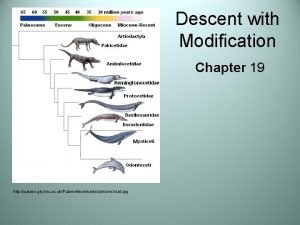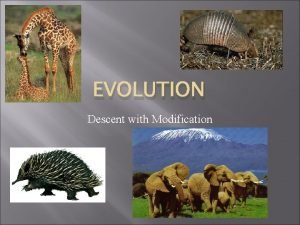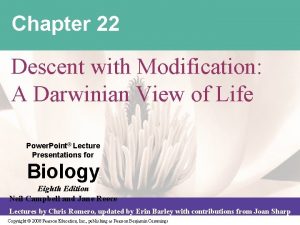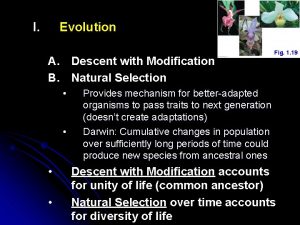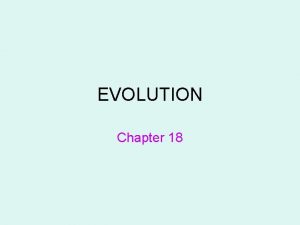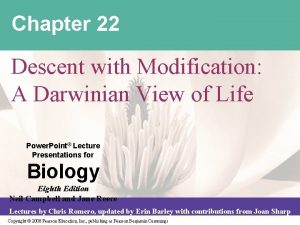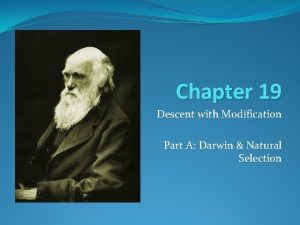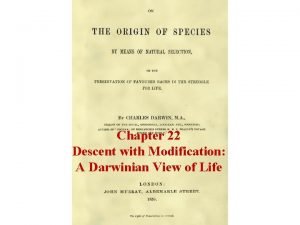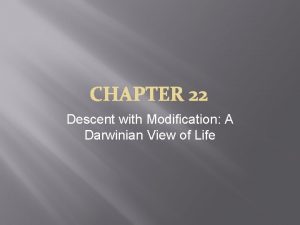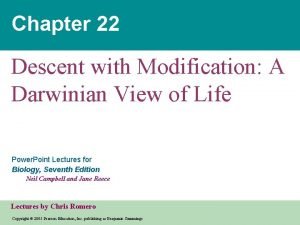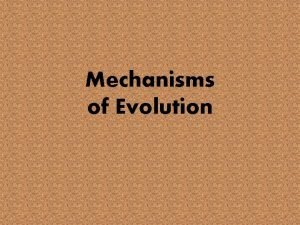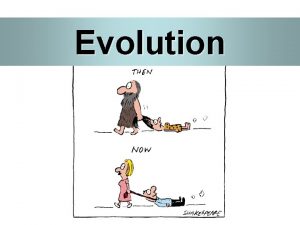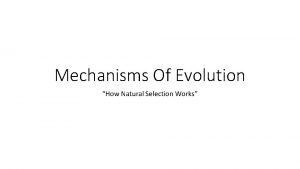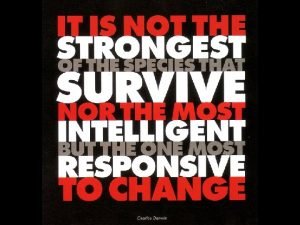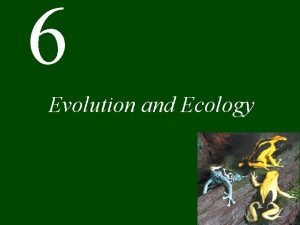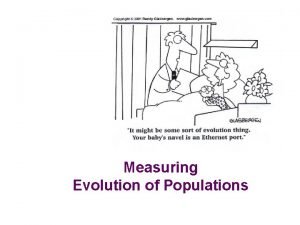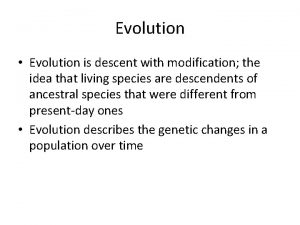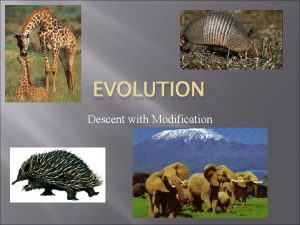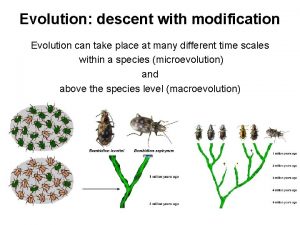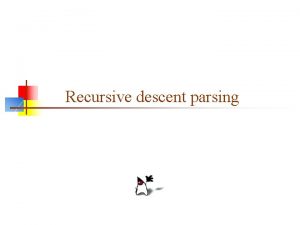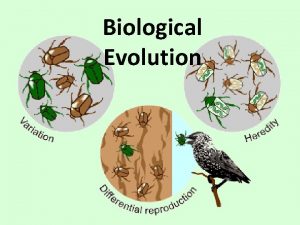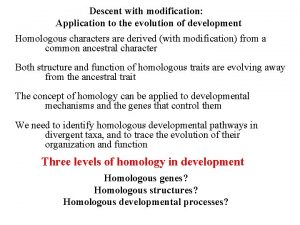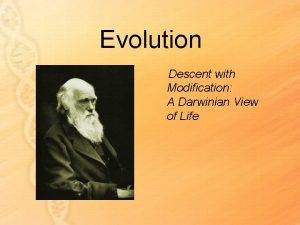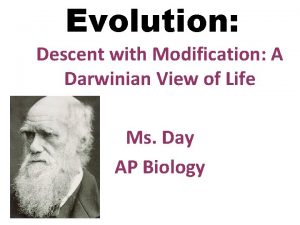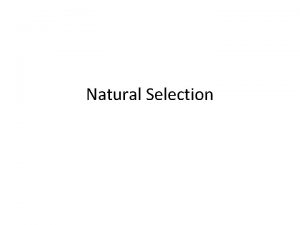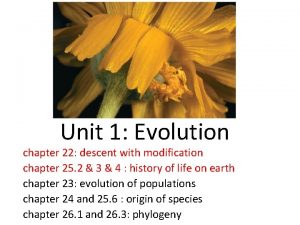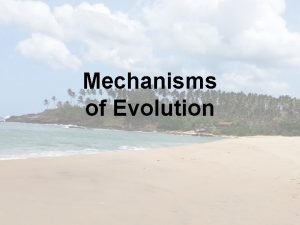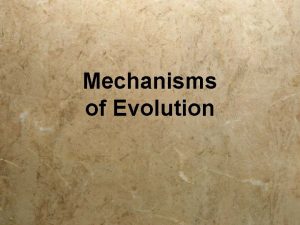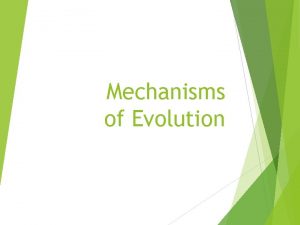Mechanisms of Evolution Descent with Modification Some of


























- Slides: 26

Mechanisms of Evolution

“Descent with Modification” Some of the questions that evolutionary biologists are trying to answer include: » Does evolution tend to proceed slowly and steadily or in quick jumps? » Why are some clades very diverse and some unusually sparse? » How does evolution produce new and complex features? » Are there trends in evolution, and if so, what processes generate them?

Evolution Vocab: » Evolution: change over time; descent with modification » Species: organisms that can sexually reproduce and produce fertile offspring » Population: large group of organisms that can breed and produce offspring » Natural Selection: Survival of the Fittest! » Adaptation: a trait that helps an organism survive and reproduce

How does a new species evolve? » Speciation: development of a new species Species can evolve. . . Through… a. Gradualism b. Punctuated Equilibrium

CHANGE OVER TIME » Gradualism: differences gradually evolve in populations as they become adapted to their local environments. ⋄ Large changes occur through the steady accumulation of small changes.

Examples of Gradualism » Small variations occur over time in a population of wolves – larger ears, longer teeth, and a heightened sense of smell. Wolves with these helpful traits tend to survive better than those without; as time progresses slowly, the traits gradually become the norm among the population. » Over a long period of time, tigers develop the combination of orange and black stripes, which allow them to hide in tall grasses as they stalk their prey. This trait eventually becomes one of the distinguishing features of tigers, as the coloring on all future tigers changes to adopt the orange and black stripe coloring. https: //youtu. be/0 Mmc. Cn. DMP 1 U

CHANGE OVER TIME » Punctuated Equilibrium: Punctuated equilibrium states that evolution only takes place in bursts of time that are rapid. However, the term "rapid, " in evolutionary terms should be understood to mean approximately 500, 000 years in some circumstances.

Examples of Punctuated Equilibrium » A species of sea animals lives, breeds, and dies for thousands of years. Suddenly, the sea level changes and the animals must adapt. Their bodies develop in order to accommodate the environmental change, and from then on are evolutionarily different from their ancestors. » Some argue that the evolution of monkey into man is actually a form of punctuated equilibrium as there are periods of no change (in stasis) and periods of what appears to be rapid and pronounced change. » A variety of dinosaurs including Stegoceras, Tyrannosauras, Syracosaurs, and Lambeosaurus all show signs of punctuated equilibrium that aligns with environmental changes such as sea level change that might have caused a need for evolutionary adaptation

MECHANISMS OF EVOLUTION

5 Mechanisms of Evolution: 1. 2. 3. 4. 5. Isolation Genetic Drift Natural Selection Gene Flow Mutations

Isolation - 4 TYPES » Geographic Isolation - different locations » Behavioral Isolation - different behaviors (mating) » Temporal Isolation - different mating seasons » Reproductive Isolation - incompatible reproductive organs » Hard for us to imagine, but a big issue for insects with variably shaped genitalia!


GENETIC DRIFT » Genetic Drift: LOSS of genetic variation by chance ⋄ Tends to be a phenomenon amongst smaller populations, while natural selection holds sway in larger populations ⋄ Can only happen if there is genetic variation!

Two Types of Genetic Drift 1. Founder Effect: occurs when a new colony is started by a few members of the original population 1. Bottleneck Effect: when a population's size is reduced for at least one generation

Founder Effect Example » The Afrikaner population of Dutch settlers in South Africa is descended mainly from a few colonists. Today, the Afrikaner population has an unusually high frequency of the gene that causes Huntington's disease, because those original Dutch colonists just happened to carry that gene with unusually high frequency. This effect is easy to recognize in genetic diseases, but of course, the frequencies of all sorts of genes are affected by founder events. » Blue People of Kentucky https: //youtu. be/7 d-07 Ced 410

Bottleneck Effect Example Northern elephant seals have reduced genetic variation probably because of a population bottleneck humans inflicted on them in the 1890 s. Hunting reduced their population size to as few as 20 individuals at the end of the 19 th century. Their population has since rebounded to over 30, 000 — but their genes still carry the marks of this bottleneck: they have much less genetic variation than a population of southern elephant seals that was not so intensely hunted.

3 Types of Natural Selection 1. Directional 2. Stabilizing 3. Disruptive

Directional Selection: selects 1 extreme


Stabilizing Selection: selects the ‘average’ in the population


Disruptive Selection: selects FOR both extremes


GENE FLOW (MIGRATION) » Gene Flow: any movement of genes from one population to another

MUTATIONS » Mutations: random changes in the DNA of an organism, which is then passed on to its offspring » A mutation could cause parents with the gene for green pigment to have an offspring with a gene for brown pigment. » This would increase the frequency of brown pigment genes in the population.

Vocab ● Fossils: preserved remains ● Homologous Structure: same structure, but different function SHOWS common ancestry ex: wing of bat and human hand ● Analogous Structure: same function, but different structure ex: bat wing and butterfly wing ● Vestigial Structure: structures that serve little to no function, but used to ○ Evidence of change ex: appendix and tailbone in humans ● Comparative Anatomy: looking at the structures in different organisms ● Embryology: study of embryos ● Cladogram: family tree of related species
 Darwin
Darwin Descent with modification
Descent with modification Criteria for natural selection
Criteria for natural selection Chapter 22: descent with modification
Chapter 22: descent with modification Descent with modification definition
Descent with modification definition Ontogeny recapitulates phylogeny
Ontogeny recapitulates phylogeny Ch 22 descent with modification
Ch 22 descent with modification Carolus linnaeus
Carolus linnaeus Chapter 22 descent with modification
Chapter 22 descent with modification Chapter 22 descent with modification
Chapter 22 descent with modification Survival for the fittest
Survival for the fittest Descent with modification: a darwinian view of life
Descent with modification: a darwinian view of life Mechanisms of evolution
Mechanisms of evolution Mechanisms of evolution
Mechanisms of evolution Evolution mechanisms
Evolution mechanisms Evolution graphic organizer
Evolution graphic organizer Hemoglobin c
Hemoglobin c Mechanism of evolution
Mechanism of evolution 5 fingers of evolution
5 fingers of evolution 1 in 1700 us caucasian newborns have cystic fibrosis
1 in 1700 us caucasian newborns have cystic fibrosis Some say the world will end in fire some say in ice
Some say the world will end in fire some say in ice Sometimes you win some sometimes you lose some
Sometimes you win some sometimes you lose some Some say the world will end in fire some say in ice
Some say the world will end in fire some say in ice Nouns cake
Nouns cake Some trust in horses
Some trust in horses Contact vs noncontact forces
Contact vs noncontact forces They say it only takes a little faith
They say it only takes a little faith

